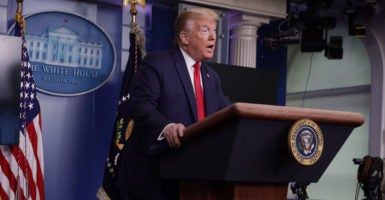To help jump-start an American economy that’s stalled because of the coronavirus, President Donald Trump is looking to an unlikely source of power: The hardworking Americans who have always made it go.
Instead of trying to regulate a recovery—as many of his predecessors have done in difficult times—the president is launching a new round of regulatory relief, putting Washington’s confidence in the American people, where it belongs.
At a Cabinet meeting earlier this month, President Donald Trump signed a new executive order on regulatory relief to support economic recovery.
>>> When can America reopen? The National Coronavirus Recovery Commission, a project of The Heritage Foundation, is gathering America’s top thinkers together to figure that out. Learn more here.
The order requires agencies to speed the nation’s economic recovery by rolling back burdensome rules, giving regulated parties quick determinations about the acceptability of proposed conduct, deprioritizing the enforcement of rules against those operating in good faith—especially small businesses—and ensuring fairness in administrative enforcements and adjudications.
The Heritage Foundation’s National Coronavirus Recovery Commission agreed with that approach in its recent report, and it recommended numerous agency-level deregulatory actions that might flow from the executive order.
Briefly, the following are several key provisions of the order.
Review and Rollback: The order directs agencies to review all rules that have recently been waived or modified to address COVID-19 and to determine whether those rules ought to be rewritten or eliminated for the long term.
That’s similar to the commission’s recommendation that the “President should direct by executive order that all agencies involved in the management of this public health emergency inventory, review, and consider making long-term modifications to all regulatory actions that have been waived, modified, or otherwise implicated in the government’s response to COVID-19.”
As the commission noted, this reform is important because America needs “long-term programmatic reforms to ensure that our regulatory regimes work in good times and bad, and that our programs facilitate innovation and market advancement while also securing health and safety.”
Reprioritized Enforcement: The order requires agencies to give regulated parties quick feedback on whether planned actions are consistent with legal and regulatory requirements, and it directs them to consider publishing policies of enforcement discretion that, to the fullest extent possible, “decline enforcement against persons and entities that have attempted in reasonable good faith to comply with applicable statutory and regulatory standards … .”
That’s similar to the commission’s recommendation that “the President direct agencies not to enforce a range of regulations against small businesses,” which “would send a very strong signal to businesses that the government is not going to come down hard on them as they try to get back up and running.”
Fair Enforcement and Adjudication: The order further directs agencies to revise their enforcement and adjudication procedures to reflect a strong commitment to principles of fairness in administrative enforcement and adjudication proceedings.
In elaborating on how those procedures ought to be revised, the order provides 10 good-government principles and practices to consider.
For example, enforcement proceedings should be prompt and fair, agency adjudicators should be independent of agency enforcement staff, and the rules of evidence and procedure used by the agency should be “public, clear, and effective.”
Those are all excellent, apolitical guidelines for the agencies to consider as they reevaluate their enforcement and adjudication procedures.
Broad Application: Finally, it’s worth noting that the executive order requires most of the so-called independent agencies and commissions to take the same actions required of Cabinet agencies and departments.
That’s an important step that makes clear the president agrees with the majority of scholars and experts, who have long recommended that presidents play a more significant role in supervising the regulatory functions of the historically independent agencies.
For example, see reports and recommendations from the American Bar Association, the Administrative Conference of the United States, the Institute for Policy Integrity at New York University School of Law, The Heritage Foundation, and the National Coronavirus Recovery Commission.
As suggested in those reports and a recent letter from U.S. senators, the next step is for the president to require cost-benefit analyses and centralized regulatory review of the independent agencies.
Conclusion: The president’s new executive order makes clear that he thinks economic growth and recovery will come through decreased Washington intervention and increased freedom for hardworking American families and businesses.
That approach served the president and nation well prior to the pandemic, and it is reasonable to think it will now contribute positively to the nation’s economic recovery.





























